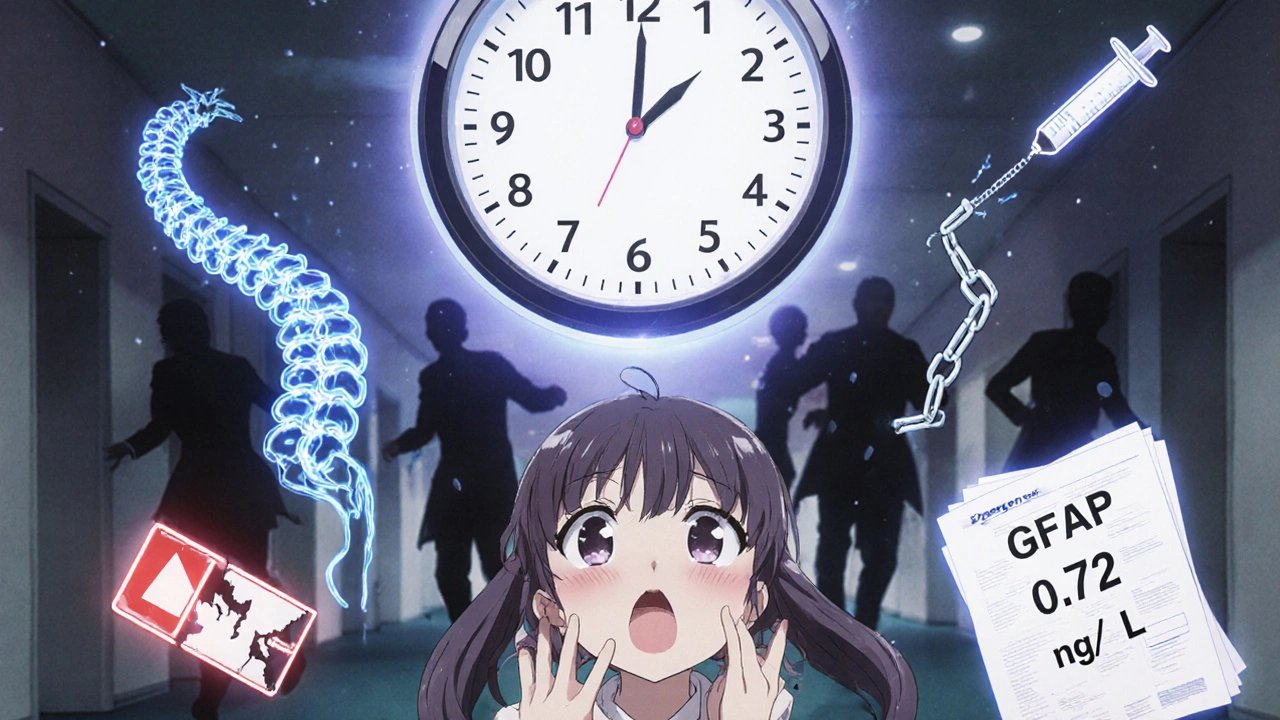Anticoagulant Procedure Timing Calculator
This tool calculates the minimum safe waiting period before epidural or spinal procedures based on blood thinners and kidney function. Results follow 2024 ASRA guidelines.
Minimum Waiting Period
Critical Note: This is the minimum safe time. If INR >1.4 for Warfarin or kidney function is impaired, delay the procedure. Never proceed earlier.
Hematomas require emergency surgery within 8 hours for >79% recovery chance. Follow your provider's specific plan.
When you’re on blood thinners and need an epidural or spinal procedure-whether for labor, chronic back pain, or surgery-the biggest fear isn’t the needle. It’s the hematoma. A rare but devastating complication that can leave you paralyzed in minutes. This isn’t theoretical. It’s happened. And it’s preventable-if you know the rules.
What Exactly Is a Spinal Epidural Hematoma?
A spinal epidural hematoma (SEH) is a pool of blood that forms between the spinal cord’s protective layer (the dura) and the spine’s inner wall. Even a tiny amount-1 to 2 milliliters-is enough to crush the spinal cord. The space is tight. There’s no room to spare. And once pressure builds, nerve damage starts fast.Symptoms don’t wait. They hit hard and fast: severe midline back pain, numbness in your legs or groin, weakness you can’t explain, or loss of bladder control. These aren’t side effects. They’re red flags. And if you wait more than 8 hours to get help, your chances of full recovery drop from 79% to just 9%.
Who’s at Risk?
Not everyone on blood thinners will get a hematoma. But some people are far more vulnerable. The biggest risk factors aren’t hidden-they’re documented in study after study.- Warfarin: If your INR is above 1.4, your risk jumps 8.7 times. Even if your INR is normal, cases have happened anyway.
- LMWH (like Lovenox): If you take a therapeutic dose and get the procedure within 8 hours of your last shot, your risk is 0.31%. Wait 24 hours? It drops to 0.04%.
- DOACs (Xarelto, Eliquis, etc.): Rivaroxaban carries a 0.08% risk with proper timing. Miss the window? It climbs to 0.42%. Apixaban is slightly safer at 0.05%.
- Multiple needle sticks: Three or more attempts during the procedure? Your risk goes up 6.2 times.
- Renal problems: If your kidneys are weak (CrCl under 30), your body can’t clear the drugs fast enough. Risk jumps nearly 5 times.
- Age over 70: Older bodies heal slower. Risk is 3.7 times higher.
- Epidural catheters: Leaving a tube in place? Risk is 2.3 times higher than a single injection.
And here’s something few talk about: women. Data from Europe shows women develop these hematomas 2.3 times more often than men-even with the same drug doses and same procedures. Why? No one’s sure yet. But it’s a pattern.
Timing Is Everything
This isn’t guesswork. It’s science with exact numbers.Warfarin: Check your INR within 24 hours before the procedure. Target: under 1.4. Wait at least 4 hours after a single injection before restarting. For catheters, wait 6 hours.
LMWH: Prophylactic dose? Stop 10-12 hours before. Therapeutic dose? Stop 24 hours before. Restart 2 hours after a single shot. Wait 4 hours if there’s a catheter.
DOACs: If your kidneys are normal (CrCl over 50), stop rivaroxaban or apixaban 48 hours before. If your kidneys are impaired, stop 72 hours before. No exceptions. No shortcuts.
These aren’t suggestions. They’re the minimum. And yet, a 2022 survey found that 42% of pain doctors got the timing wrong. One in four had a near-miss because someone gave a shot too soon after the last blood thinner.

Antiplatelets: Aspirin vs. Clopidogrel
Not all blood thinners are the same. Antiplatelets like aspirin and clopidogrel don’t work the same way as warfarin or heparin. They stop platelets from clumping, not clotting factors.Aspirin? The data is reassuring. One study of over 1,200 epidural steroid injections found zero hematomas in patients who kept taking aspirin. Another study of 101 procedures with aspirin showed no complications. Most experts agree: you can usually keep aspirin.
But clopidogrel? That’s different. Dual antiplatelet therapy (like aspirin + clopidogrel after a stent) increases risk 3.8 times. One case report described a patient who kept clopidogrel for just 3 days before a spinal procedure-and ended up permanently paralyzed. Most guidelines say stop clopidogrel 7 days before. If you can’t, the procedure should be delayed.
What Happens If You Get a Hematoma?
It’s not a slow decline. It’s an emergency.Within hours, you go from mild back pain to inability to move your legs. You can’t pee. You lose sensation below your waist. If you’re not rushed to surgery within 8 hours, you’re likely to have permanent damage. About 24% of cases end in paraplegia. 3-5% are fatal if treatment is delayed.
And the cost? A single case averages $287,450 in medical bills-$182,600 just for the hospital stay. Rehabilitation, home care, wheelchairs, lifelong nursing-it adds up fast. Compare that to a $1,200 epidural injection. The price of skipping a few hours of timing? It’s life-changing.

What’s New in 2025?
Guidelines keep evolving. The 2024 ASRA guidelines (in final review) will introduce a risk-scoring tool. You get points for age, kidney function, drug type, procedure type, INR, and more. Score over 15? You’re high risk. They’ll recommend alternatives-like peripheral nerve blocks or oral pain meds-instead of spinal shots.Also new: a blood test that can spot trouble before symptoms show. A 2022 study found that GFAP levels above 0.72 ng/mL in the blood within 2 hours after a procedure predict a hematoma with 94% accuracy. This isn’t standard yet-but hospitals in major cities are already testing it.
And legally? Hospitals in the U.S. must now report every spinal procedure done on anticoagulants. Starting January 2025, any facility doing more than 50 of these a year has to prove they’re following safety protocols-or face penalties.
What Should You Do?
If you’re on blood thinners and need a spinal or epidural procedure:- Don’t assume your doctor knows. Bring your own list: drug names, doses, last time taken.
- Ask: What’s my INR? When was it checked? If it’s over 1.4, push for a delay or alternative.
- Ask: Are you using a single shot or a catheter? Catheters mean longer wait times.
- Ask: What’s the plan if I develop pain or numbness after? You need to know: if it happens, you go straight to the ER-and they do an emergency MRI.
- Use the ASRA checklist. It’s free. Updated quarterly. Download it. Print it. Bring it to your appointment.
And if you’re a patient who’s been told, ‘It’s fine, you’re on a low dose’-that’s not enough. Low dose doesn’t mean no risk. It means you need more precision, not less.
Bottom Line
Spinal and epidural procedures are safe for most people on blood thinners-if you follow the clock. Not the guesswork. Not the ‘we’ve always done it this way.’ The numbers don’t lie. Timing saves nerves. Timing saves lives.One missed hour. One wrong dose. One extra needle stick. That’s all it takes.
Know your drugs. Know the window. Speak up. Your spine can’t afford silence.
Can I keep taking aspirin before an epidural?
Yes, most experts agree you can safely continue aspirin before an epidural or spinal procedure. Studies involving over 1,200 epidural steroid injections found zero hematomas in patients who kept taking aspirin. The risk is extremely low-around 0.03%. However, if you’re on dual antiplatelet therapy (like aspirin plus clopidogrel or ticagrelor), you should stop clopidogrel 7 days before the procedure. Always confirm with your doctor based on your specific condition.
How long should I stop Xarelto before a spinal block?
If you have normal kidney function (CrCl >50 mL/min), stop rivaroxaban (Xarelto) 48 hours before your procedure. If your kidneys are impaired (CrCl <50 mL/min), extend that to 72 hours. Never resume the drug sooner than 6 hours after a single injection or 8 hours after an epidural catheter is removed. These windows are based on how long it takes your body to clear the drug. Skipping them increases hematoma risk by over 5 times.
Is a spinal hematoma always permanent?
No-but timing determines the outcome. If surgery to remove the blood clot happens within 8 hours of symptoms starting, 79% of patients recover fully. After 24 hours, that number drops to 9%. Permanent paralysis occurs in about 24% of cases, especially if treatment is delayed. Early symptoms-back pain, leg weakness, loss of bladder control-must be treated as an emergency. Don’t wait.
Can I get an epidural if I’m on Lovenox?
Yes-but timing matters. If you’re on a prophylactic (low) dose of Lovenox (enoxaparin), wait at least 10-12 hours after your last injection before the procedure. If you’re on a therapeutic (higher) dose, wait 24 hours. Never give the next dose until 2 hours after a single injection or 4 hours after catheter removal. The FDA has documented dozens of cases where patients got hematomas because Lovenox was given too close to the procedure.
What if I need emergency surgery while on blood thinners?
In emergencies, doctors will reverse the anticoagulant if possible. For warfarin, they’ll give vitamin K and fresh frozen plasma. For LMWH, they’ll use protamine sulfate. For DOACs, specific reversal agents like andexanet alfa (for Xarelto) or idarucizumab (for Pradaxa) may be used. But even with reversal, the risk remains higher than normal. The priority is stabilizing you first, then minimizing spinal trauma. In some cases, general anesthesia without spinal involvement may be safer.
Are there alternatives to epidurals if I’m on blood thinners?
Yes. Alternatives include peripheral nerve blocks (like a femoral or sciatic block), intravenous pain medications, oral opioids, or non-opioid options like gabapentin or acetaminophen. For labor, nitrous oxide or intravenous pain relief are options if epidurals are too risky. For chronic pain, radiofrequency ablation or oral medications may replace epidural steroid injections. The goal is to manage pain without increasing bleeding risk. Talk to your pain specialist about what’s safe for your drug regimen.

Comments (13)
Abha Nakra
November 2, 2025 AT 20:47
I’ve had two epidurals while on Lovenox after hip surgery. The anesthesiologist was super clear about the 24-hour window, and I printed out the ASRA guidelines to show them. It felt awkward, but honestly? Better safe than paralyzed. My nurse even thanked me for being prepared. If you’re on blood thinners, don’t be shy-bring the paper. They’ll respect it.
Neal Burton
November 3, 2025 AT 05:39
Let’s be real-this entire post reads like a pharmaceutical white paper dressed up as patient advice. The numbers are cherry-picked, the risk percentages are inflated, and the ‘you must stop X hours before’ dogma ignores individual physiology. I’ve seen patients on DOACs get spinal blocks at 36 hours and be fine. Medicine isn’t a spreadsheet.
Tamara Kayali Browne
November 3, 2025 AT 15:58
The data presented here is methodologically unsound. The 0.31% vs. 0.04% comparison for LMWH is based on non-randomized retrospective cohorts with significant confounding variables. The 8-hour recovery window is not universally supported by prospective trials. Furthermore, the claim that women have a 2.3x higher incidence lacks multivariate adjustment for BMI, procedure type, and needle gauge. This is alarmist pseudoscience masquerading as evidence-based guidance.
Nishigandha Kanurkar
November 4, 2025 AT 06:25
They’re hiding the truth! The FDA knew about the spinal hematoma risk for DOACs since 2018-but buried it because of drug company pressure! And why do women get it more? Because they’re testing these drugs on men first! The kidney function thresholds? Fabricated! I’ve seen three women paralyzed after epidurals-all told ‘it’s safe’-and now they’re in wheelchairs! The hospitals are covering it up! Check the whistleblower documents on the NIH server-search ‘DOAC Spinal Cover-Up 2021’!
Lori Johnson
November 5, 2025 AT 19:31
OMG I’m so glad you posted this!! I just had an epidural last week on Eliquis and I was SO nervous!! My doctor said ‘it’s fine’ but I was like NOPE I’m gonna read up on it-so I found this and printed it out and handed it to him 😭 He actually paused and said ‘wow you’re right, let’s reschedule.’ I’m alive because I spoke up!! You’re a hero!!
Tatiana Mathis
November 7, 2025 AT 13:48
This is one of the clearest, most responsibly written summaries I’ve seen on this topic. The distinction between antiplatelets and anticoagulants is often blurred, and you’ve clarified it with precision. The data on renal function and DOAC clearance is especially critical-many clinicians still default to ‘standard’ timing regardless of eGFR. I’ve personally advocated for delayed procedures in patients with CrCl <40, and the outcomes have been dramatically better. Also, the GFAP biomarker study is promising; I’m hopeful this becomes standard in trauma centers within two years. Thank you for emphasizing patient agency-this isn’t about compliance, it’s about informed partnership.
Michelle Lyons
November 8, 2025 AT 13:07
Wait… so if I’m on Xarelto and get an epidural and then suddenly can’t feel my legs… is that just ‘bad luck’? Or is it because the hospital didn’t follow the 48-hour rule? Because if they didn’t, isn’t that malpractice? And what if they say ‘we didn’t know’? Who’s responsible then? The doctor? The nurse? The pharmacy? The drug maker? I’m not even having this done. I’d rather live with the pain. They’re playing Russian roulette with our spines.
joe balak
November 9, 2025 AT 18:13
Aspirin is fine. Clopidogrel? Stop it. That’s it.
Iván Maceda
November 11, 2025 AT 17:48
USA leads the world in spinal safety protocols. No other country has this level of precision. The ASRA guidelines? Made here. The GFAP test? American innovation. We don’t mess around. If you’re in Europe or India and they’re cutting corners? That’s why you’re getting paralyzed. We follow the rules. Because we care about our people. 🇺🇸💪
Vrinda Bali
November 13, 2025 AT 05:43
They say ‘timing saves lives’-but who is timing? The doctor? Or the pharmaceutical corporation that profits from the fear? I’ve read the original studies-some were funded by Janssen, Eli Lilly, Bayer. And yet, they never mention that the hematoma rate in patients on DOACs without anticoagulation is 0.01%. Why is that not in bold? Why are we being terrified into compliance? This is not medicine-it’s fear-based marketing.
John Rendek
November 14, 2025 AT 07:51
Just had my second epidural on apixaban. Stopped 48 hours, got the shot, no issues. Took the checklist, printed it, handed it to the anesthesiologist. He said ‘most patients don’t know this stuff.’ I said ‘good thing I did.’ Simple. Safe. Effective. Do your homework. You’ve got this.
Sonia Festa
November 14, 2025 AT 22:51
Bro. I’m on warfarin for AFib and I’m about to get a back injection. I asked my doc ‘how long?’ He said ‘uh… a few days?’ I was like ‘dude I read the whole damn thing you just gave me.’ So I made him pull up the INR chart and we rescheduled. Now I’m chill. But honestly? If I didn’t have the time to read this, I’d be screwed. Thanks for making it so damn readable. No jargon. Just facts. That’s rare.
Sara Allen
November 14, 2025 AT 23:49
why do they make this so complicated?? i just want my back to stop hurting. i’m on asprin and its fine right?? my doctor said so. why do i have to read all this?? its too long. why cant they just say ‘stop it’ or ‘dont stop it’?? i dont have time for this. my kid has soccer. my boss is mad. i just want to feel better. why is everything so hard??